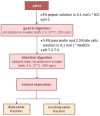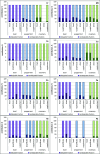Evaluation of the Bioaccessibility of Essential and Toxic Trace Elements in Basil, Peppermint, and Rosemary Using an In Vitro Gastrointestinal Digestion Model
- PMID: 40020160
- PMCID: PMC11907404
- DOI: 10.1021/acs.jafc.4c10940
Evaluation of the Bioaccessibility of Essential and Toxic Trace Elements in Basil, Peppermint, and Rosemary Using an In Vitro Gastrointestinal Digestion Model
Abstract
Herbs, well-known for their antioxidant properties, are a common component of the human diet. In this work, for the first time, the bioaccessibility of essential (Mn, Fe, Cu, Zn, Co, Cr, and Se) and toxic trace elements (Ni, Cd, As, Pb, and Hg) in spice plants: basil, peppermint, and rosemary was studied using an in vitro gastrointestinal digestion process and artificial dialysis membranes. The different forms of plants, fresh, lyophilized, and dried (as spice and dietary supplements), were analyzed. The results show that the bioaccessibility of elements depends on the type of plants, their form, and origin. Relatively high bioaccessibility of Cu (24-84%), Mn (39-52%), and Zn (8-43%) was observed in fresh and lyophilized herbs. The lowest value was obtained for Fe (<2%) in all herbs. The lyophilization process did not affect the trace elements' bioaccessibility in herbs. The total phenolic content was positively correlated with the total content of elements in all tested spice plants.
Keywords: ICP–MS; artificial dialysis membrane; enzymatic digestion; essential elements; lyophilization; spice plants; total phenolic content.
Conflict of interest statement
The authors declare no competing financial interest.
Figures




Similar articles
-
Room temperature solvent extraction for simple and fast determination of total concentration of Ca, Cu, Fe, Mg, Mn, and Zn in bee pollen by FAAS along with assessment of the bioaccessible fraction of these elements using in vitro gastrointestinal digestion.J Trace Elem Med Biol. 2020 Jul;60:126479. doi: 10.1016/j.jtemb.2020.126479. Epub 2020 Feb 28. J Trace Elem Med Biol. 2020. PMID: 32142959
-
Bioaccessibility of Cr, Cu, Fe, Mg, Mn, Mo, Se and Zn from nutritional supplements by the unified BARGE method.Food Chem. 2014 May 1;150:321-7. doi: 10.1016/j.foodchem.2013.10.151. Epub 2013 Nov 4. Food Chem. 2014. PMID: 24360457
-
In Vitro Assessment of the Physiologically Relevant Oral Bioaccessibility of Metallic Elements in Edible Herbs Using the Unified Bioaccessibility Protocol.Molecules. 2023 Jul 14;28(14):5396. doi: 10.3390/molecules28145396. Molecules. 2023. PMID: 37513269 Free PMC article.
-
Determination of selected trace elements in herbs and their infusions.Sci Total Environ. 2002 Apr 22;289(1-3):33-40. doi: 10.1016/s0048-9697(01)01015-4. Sci Total Environ. 2002. PMID: 12049404
-
Investigation of the Influence of Selected Soil and Plant Properties from Sakarya, Turkey, on the Bioavailability of Trace Elements by Applying an In Vitro Digestion Model.Biol Trace Elem Res. 2015 Nov;168(1):276-85. doi: 10.1007/s12011-015-0330-7. Epub 2015 Apr 18. Biol Trace Elem Res. 2015. PMID: 25893363
Cited by
-
Dietary Zn-Recent Advances in Studies on Its Bioaccessibility and Bioavailability.Molecules. 2025 Jun 25;30(13):2742. doi: 10.3390/molecules30132742. Molecules. 2025. PMID: 40649260 Free PMC article. Review.
References
-
- Potortì A. G.; Bua G. D.; Turco V. L.; Tekaya A. B.; Beltifa A.; Mansour H. B.; Dugo G.; Bella G. D. Major, minor and trace element concentrations in spices and aromatic herbs from Sicily (Italy) and Mahdia (Tunisia) by ICP-MS and multivariate analysis. Food Chem. 2020, 313, 126094.10.1016/j.foodchem.2019.126094. - DOI - PubMed
-
- Ghasemzadeh A.; Ashkani S.; Baghdadi A.; Pazoki A.; Jaafar H. Z. E.; Rahmat A. Improvement in Flavonoids and Phenolic Acids Production and Pharmaceutical Quality of Sweet Basil (Ocimum basilicum L.) by Ultraviolet-B Irradiation. Molecules 2016, 21, 1203.10.3390/molecules21091203. - DOI - PMC - PubMed
-
- Alu’datt M. H.; Rababah T.; Alhamad M. N.; Gammoh S.; Al-Mahasneh M. A.; Tranchant C. C.; Rawshdeh M.. Chapter 15 - Pharmaceutical, nutraceutical and therapeutic properties of selected wild medicinal plants: Thyme, spearmint, and rosemary. In Therapeutic, probiotic, and unconventional foods, 1st ed.; Grumezescu A. M., Holban A. M., Eds.; Academic Press, 2018, pp 275–290. 10.1016/B978-0-12-814625-5.00014-5. - DOI
MeSH terms
Substances
LinkOut - more resources
Full Text Sources
Research Materials

